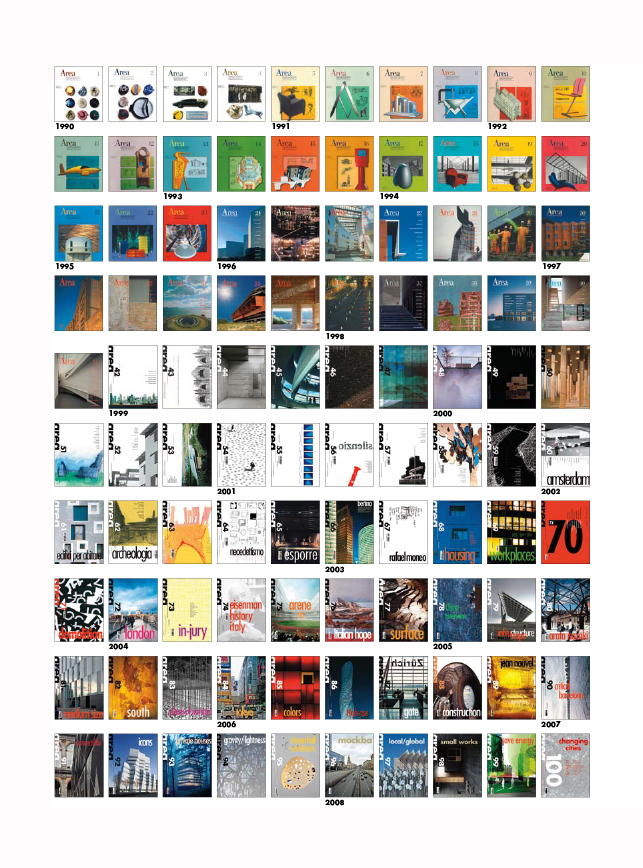Issue number 100 of Area inevitably forces us to look inwards and backwards, to reflect on the history of the magazine, how it all began, or rather how the cultural aims of Area came to be defined, and where this kind of story, which at least for now will continue in the furrow of continuity, will eventually arrive. To the most rigorous and intransigent of us 100 is merely a number, just another point in an arithmetic sequence, but for all of us in the editorial office, passionately involved in this adventure, it stands for more than 16,000 pages telling the story of the virtues and defects of our research, about 12,500 images of architectures and hundreds and hundreds of articles and reflections on themes tackling even the most unusual and complex visual angles of our discipline. Looking at the covers, lined up along one another, at least from 24 – before I became editor I had a quite low profile as architecture editor – my mind is filled by intense memories and sentiments of appreciation and gratitude towards those who have helped us unreservedly in these years, not to mention the infinite discussions and debates on a critical reading of architectural design, the meaning or value of a certain work in relation to its context. The beginning of this adventure coincides with the creation of the magazine, mainly dedicated to design and photography, in the late Eighties with the determinant contribution of Gabriele Basilico and the editorial direction of Giovanni Baule. It was a matter of a quarterly published by Azzurra Editrice, a small Milanese publisher, and the first issue was presented in March 1980. The magazine immediately gained recognition as a cult object, with its carefully studied design, and a few years later it won the Compasso d’Oro for its graphic quality. Azzurra Editrice was transformed into Progetto Editrice, which continued publishing Area in spite of difficulties until 1999, even if I had accepted to become the editor of the magazine in as of the January/February issue of 1996, moving the editorial office from Milan to Florence, increasing the number of issues from four to six and above all focusing with increasing conviction on the world of architectural design. The magazine gradually gained international recognition. As of issue number 42 it was transferred from Progetto Editrice to Federico Motta Editore; the graphic design was entrusted to AG Franzoni and it was given a new format and image. Issue after issue, Area grew in terms of number of pages and columns, consolidating its role in the architecture publishing scenario. With number 88 of September/October 2008 the publishing house changed name; due to its successes in the architecture sector, Motta Architettura was founded and commenced to publish the magazine under a new logo. Part of Motta Architettura was taken over by the Sole 24 ORE Group in 2007, becoming its most important architecture magazine. Every year Area presents a monographic issue dedicated to a reading of and dialogue with a contemporary architect, and another one dedicated to a city, its transformations, changes. Now and then it also features supplements on specific technical and professional research themes. And the magazine is more than what appears on paper; it also organizes events and exhibitions, promotes debates and discussions, presents competitions or participates in them by appointing jury members; the magazine is a kind of workshop which has never ceased to keep us up to date for 12 years, and finally it is the feather in the hat of a leading publishing group which has not hesitated to set its stakes on Area, by buying the magazine and making it part of the prestigious “Sole”.
18 anni in 100 numeri
area 100
| changing cities





